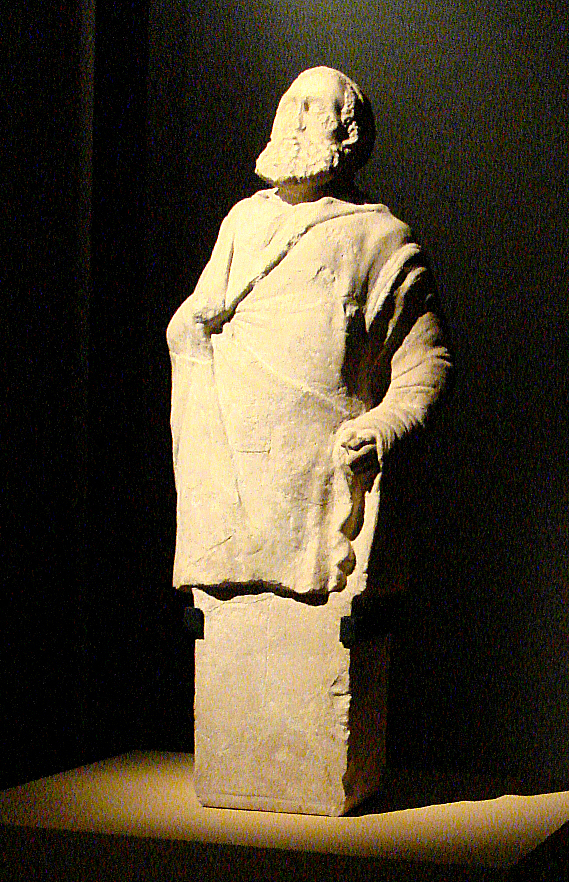Herm

|
| This hermaic sculpture depicts an old philosopher; it dates from the 2nd century BC. |
A herm (or herma) is a rectangular pillar topped with a head or bust. It is believed these structures were used in Ancient Greece to mark boundaries and were often inscribed with distances.
The word herm may be representative of the Greek phrase for blocks of stone, but it may also be linked to the Greek god, Hermes. Associated with roads and borders, Hermes was a phallic god connected to the concepts of luck and fertility. Consequently, hermae frequently included carvings of genitals at the suitable height in the otherwise plain base. This symbol was apparently meant to ward off evil.
The herm was later adopted by the Romans who used it as a boundary marker. It was also a method of indicating boundaries in Renaissance and post-Renaissance times.
Herms (or hermae) sometimes took on purely decorative functions and served as sculpture-topped pedestals, either as single units or as pillars supporting figures. This application of the herm may be linked to structural supports such as the telamon (the Roman term) or atlas (also known as atlant, or atlante or atlantid), which were architectural components (such as columns, piers or pilasters) sculpted in a human form.
[edit] Related articles on Designing Buildings Wiki
Featured articles and news
RTPI leader to become new CIOB Chief Executive Officer
Dr Victoria Hills MRTPI, FICE to take over after Caroline Gumble’s departure.
Social and affordable housing, a long term plan for delivery
The “Delivering a Decade of Renewal for Social and Affordable Housing” strategy sets out future path.
A change to adoptive architecture
Effects of global weather warming on architectural detailing, material choice and human interaction.
The proposed publicly owned and backed subsidiary of Homes England, to facilitate new homes.
How big is the problem and what can we do to mitigate the effects?
Overheating guidance and tools for building designers
A number of cool guides to help with the heat.
The UK's Modern Industrial Strategy: A 10 year plan
Previous consultation criticism, current key elements and general support with some persisting reservations.
Building Safety Regulator reforms
New roles, new staff and a new fast track service pave the way for a single construction regulator.
Architectural Technologist CPDs and Communications
CIAT CPD… and how you can do it!
Cooling centres and cool spaces
Managing extreme heat in cities by directing the public to places for heat stress relief and water sources.
Winter gardens: A brief history and warm variations
Extending the season with glass in different forms and terms.
Restoring Great Yarmouth's Winter Gardens
Transforming one of the least sustainable constructions imaginable.
Construction Skills Mission Board launch sector drive
Newly formed government and industry collaboration set strategy for recruiting an additional 100,000 construction workers a year.
New Architects Code comes into effect in September 2025
ARB Architects Code of Conduct and Practice available with ongoing consultation regarding guidance.
Welsh Skills Body (Medr) launches ambitious plan
The new skills body brings together funding and regulation of tertiary education and research for the devolved nation.
Paul Gandy FCIOB announced as next CIOB President
Former Tilbury Douglas CEO takes helm.
UK Infrastructure: A 10 Year Strategy. In brief with reactions
With the National Infrastructure and Service Transformation Authority (NISTA).






















